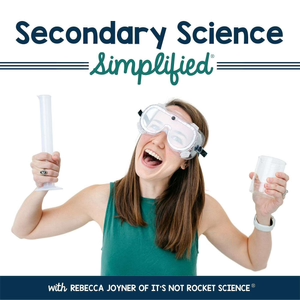
Secondary Science Simplified™
Rebecca Joyner, High School Science Teacher
1 Listener
All episodes
Best episodes
Top 10 Secondary Science Simplified™ Episodes
Goodpods has curated a list of the 10 best Secondary Science Simplified™ episodes, ranked by the number of listens and likes each episode have garnered from our listeners. If you are listening to Secondary Science Simplified™ for the first time, there's no better place to start than with one of these standout episodes. If you are a fan of the show, vote for your favorite Secondary Science Simplified™ episode by adding your comments to the episode page.
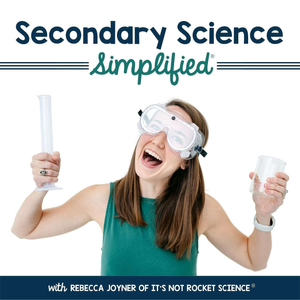
60. Teaching with Packets - What They Are, Why I Love Them, and How to Use Them
Secondary Science Simplified™
02/06/23 • 37 min
It’s almost Valentine’s Day so I knew I needed to share with you all about love at first sight! It may be a bit cheesy, but when I was first introduced to teaching with packets, I knew it was love at first sight and I’ve never looked back.
In this episode, I am sharing all the information you need to decide if teaching with packets is something you want to try with your classes. I am diving into what packets are and what is included in these packets, what teaching with packets looks like, ten reasons I absolutely love teaching with packets, and what resources can help you to create your own packets.
Be sure to grab your FREE Valentine’s Day themed high school science activities! These activities are perfect for engaging your students in a fun and worthwhile learning experience. There is one activity specifically for each subject - biology, anatomy, physics, and chemistry. Grab them today and send me a DM or email me at [email protected] when you use them with your students! I love to hear from you all when you use these free resources!
Resources Mentioned:
- Join the Secondary Science Simplified virtual professional development course waitlist
- FREEBIE: Valentine’s themed high school science activities
- A category in my store of ALL my complete units
- Send me a DM on Instagram: @its.not.rocket.science
- Send me an email: [email protected]
- Grab your Classroom Reset Challenge
- Follow, rate, and review on Apple Podcasts.
Check out the show notes for all resources mentioned in this episode: https://itsnotrocketscienceclassroom.com/episode60
1 Listener
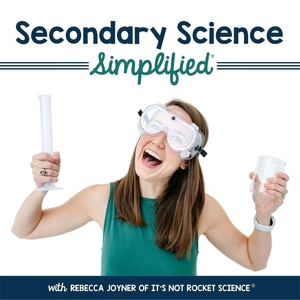
39. Organization Tips for Your Science Classroom
Secondary Science Simplified™
09/12/22 • 32 min
Do you LOVE organizing your space or does the thought of it send you running the other way? Are you thinking there’s no way you can “organize” when you aren’t in a science classroom, you have no storage, or you’re a floater who only has a cart?
You all know how much I love all things organization and I am sharing some of my favorite tips and recommendations with you to help make your teaching space (whatever that space may be) efficient and welcoming.
I have spent time teaching in several settings and have learned so much about how to best use the space I have. Today, I am sharing some of the things I’ve learned with you! We are looking at how to use the front of your classroom most effectively, suggestions for having an organized turn in area, how to make class necessities easily accessible, and some advice specifically for floaters.
PLUS, I’m sharing two bonus recommendations on how to help manage cellphones in the classroom and how to organize YOUR files.
Need some help getting your classroom reset, organized, and ready to go? Grab my FREE Classroom Reset Challenge where I walk you through 5 tasks to help get your classroom in order.
Resources:
- Download your FREE Classroom Reset Challenge.
- Natural Selection Lab
- Turn in bins
- Utility Cart
- Shoebox storage containers
- Phone caddy
- Follow, rate, and review on Apple Podcasts.
Check out the show notes for all resources mentioned in this episode: https://itsnotrocketscienceclassroom.com/episode39
1 Listener
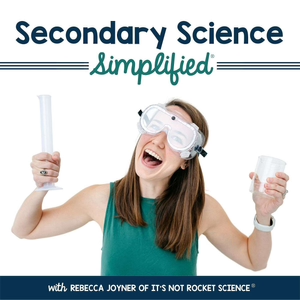
40. How to Reach EVERY Learner in Your Classroom
Secondary Science Simplified™
09/19/22 • 22 min
As teachers, we know how important it is to reach every student that walks into our classroom. But how do we go about doing that when there is such a diverse group of students in every class? Today, I am sharing 4 tips on how to reach every learner in your high school science classes.
Reaching every single one of your students can seem overwhelming but I am here to help give you practical tips to help you do just that. In this episode, I am sharing the importance of getting to know every student as a person, how eliminating homework can benefit you and your students, why you should use a variety of assessments, and the importance of checking your test questions for bias.
Our students come to us with so many different backgrounds, home lives, experiences, and preferences but there are simple things we can do in our classrooms to make sure we are reaching them all and making an impact.
Resources Mentioned:
- Complete Secondary Science Units
- Biology Midterm and Final Exam Review and Test Pack
- Anatomy Midterm and Final Exam Review and Test Pack
- Physical Science Midterm and Final Exam Review and Test Pack
- Follow, rate, and review on Apple Podcasts.
Check out the show notes for all resources mentioned in this episode: https://itsnotrocketscienceclassroom.com/episode40
1 Listener
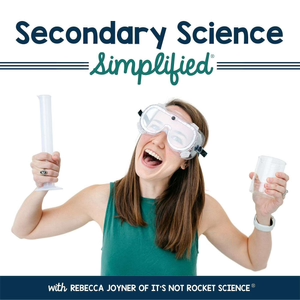
48. 5 Ways to Reclaim Your Class Time
Secondary Science Simplified™
11/14/22 • 14 min
It seems we never have enough time to do what we want to do in our class periods. How are we supposed to get labs, demos, lectures, assessments, and more squeezed into a 45 or 90 minute class? The answer: Reclaim your precious class time! You may be wondering how in the world you can do that, so today, I am sharing 5 simple changes you can make so you can cover all that you need to.
If you are looking at everything you need to get through and aren’t sure when you’ll have time to do it all, this episode is for you! I am giving you practical and simple changes you can make in your classroom to reclaim your valuable class time. I am sharing the three places time is most often wasted, how procedures are key to reduce wasted time, why you should have an agenda on your whiteboard, the power of timers and bells, and how an efficient turn-in system is a game-changer.
It is amazing how much time you can reclaim by implementing these five tips! I want to hear about what you try and how it goes. Send me a message on Instagram and share what changes you are making and if they are helping you!
Resources Mentioned:
- FREEBIE: Anatomy of a Class Period Lesson Plan
- Purchase the Bell I Use Here
- SECONDARY SCIENCE SIMPLIFIEDTM️ Professional Development Course
- Follow, rate, and review on Apple Podcasts.
Check out the show notes for all resources mentioned in this episode: https://itsnotrocketscienceclassroom.com/episode48
1 Listener

101. 6 Tips for Teaching Stoichiometry in Your Chemistry Class
Secondary Science Simplified™
10/23/23 • 19 min
When I decided to do this series, I knew exactly what I was going to discuss when it came to the difficulties of teaching chemistry. Students get overwhelmed by all the math and more intense content that comes with this science discipline, particularly teaching stoichiometry. However, there are several things you can do to ease their stress and make this unit fun for your students. So, in today’s episode, I’m sharing 6 tips for teaching stoichiometry in your chemistry class.
There are a lot of concepts in chemistry that are difficult for students to grasp and understand, which is why it’s important to bring these up early or before you teach the content. Not only does this provide multiple opportunities to practice, but when it’s mentioned in the content, they already have seen it before. Additionally, teaching chemistry is more than just content. It’s teaching students problem-solving and critical thinking skills. And one of the best ways to achieve this is by incorporating real-world scenarios, labs, and activities in order for them to see the connection.
Even though your students may be apprehensive about the chemistry content, there are still things you can do to help alleviate and diminish their stress. By implementing these 6 tips and other pieces of advice, I hope to encourage you that teaching stoichiometry to your students will be fun and academic at the same time. Tune in next week for the last episode in the series about the difficult topics teaching physics.
Resources Mentioned:
- Free Science Halloween Resources
- Stoichiometry Unit - including Magnitude of a Mole
- Chemistry Curriculum - Full Year Bundle
- Introduction to Chemistry Unit
- Dimensional Analysis Activity - Fudge Lab Expansion Pack
- Free Science Winter Resources - including Hot Chocolate Lab Activity
- Download your FREE Classroom Reset Challenge
- Send me a DM on Instagram: @its.not.rocket.science
- Send me an email: [email protected]
- Follow, rate, and review on Apple Podcasts
Show Notes: https://itsnotrocketscienceclassroom.com/episode101

95. How to STOP Grading Everything
Secondary Science Simplified™
09/11/23 • 25 min
As teachers, we know that our time is valuable and we try to create that perfect work-life balance. However, time dedicated to instruction, engaging activities, and other teaching-related tasks can consume our time in and outside the classroom. But you can decrease the amount of time you spend on one task that will save you more time and energy, which is grading!
Now, I know that grading is a mandatory and necessary component of teaching, but the amount of time teachers are spending on grading student work is way too much. I believe that there are ways you can truly stop grading everything while still having multiple preps and higher-level AP courses. In today’s episode, I’m sharing how to achieve this, two of the biggest criticisms I get, and my solutions to each.
Once you decrease the amount you’re grading, you will begin to see how it benefits both you and your students. Yes, I said students! They will appreciate your more timely feedback and get a more energized and recharged teacher, which ultimately impacts your instruction and activities.
Although the concept of not grading every assignment is scary, I promise it will be life-changing. I am living proof that this philosophy works, which has helped me create a more balanced work and home life, which also benefits my students. Join me in my grading challenge of collecting 1 thing per class per week and watch this simple change make a huge difference in your life!
Resources Mentioned:
- Bell Ringers for Biology, Physical Science, and Anatomy
- Join me for my Summer PD
- Episode 4, Engaging Your Students in the First 5 Minutes of Class
- Episode 94, How to Deal with Cheating in Your High School Science Classes
- Download your FREE Classroom Reset Challenge
- Send me a DM on Instagram: @its.not.rocket.science
- Send me an email: [email protected]
- Follow, rate, and review on Apple Podcasts
Show Notes: https://itsnotrocketscienceclassroom.com/episode95
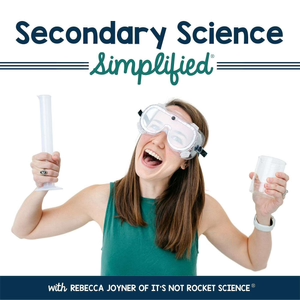
45. Using Phenomena to Engage Students
Secondary Science Simplified™
10/24/22 • 23 min
Using phenomena is a great way to engage your students but it can be so overwhelming trying to figure out what to do or how to get started. If you’re using NGSS or other standards that utilize phenomena, but are struggling to incorporate them in a meaningful way, I’m going to break it down for you! In this episode, we’re diving into engaging students through phenomena.
Resources Mentioned:
- Next Generation Science Standards
- It’s Not Rocket Science Units
- Biology everyday phenomenon: Cancer Statistics
- Biology anchoring phenomenon: Comparing Genetics
- Ecosystem in a Bottle investigation
- Support and motion unit
- Anatomy everyday phenomena: Wellness Trends
- Anatomy everyday phenomena: Heart Health
- Antibiotic Resistance Lab
- Matter Unit
- Follow, rate, and review on Apple Podcasts.
I want to hear from you! We are coming up on our 50th episode! To celebrate, I am doing an “ask me anything” episode where no topic is off limits. Submit any question you have by DM-ing me on Instagram or send me an email to [email protected].
Check out the show notes for all resources mentioned in this episode: https://itsnotrocketscienceclassroom.com/episode45

88. PRACTICAL IMPLEMENTATION: Part 5
Secondary Science Simplified™
07/27/23 • 16 min
YOU DID IT!! It is the last episode of our Curriculum Design mini-series and we are wrapping it up with a little extra support with what I think is the most challenging assessment to write, the end-of-unit tests. Now, let’s be clear, no assessment is easy to write, and writing tests is NOT for the faint of heart. Of course, I want to give you as many helpful tips as I can, so in today's episode, I am giving you a glimpse into how I write my end-of-unit tests.
As I mentioned, writing tests is challenging, and I don’t want you diving into this thinking it will be easy peasy because, quite honestly, it won’t be. However, I hope that hearing how I create my end-of-unit tests makes it a bit more manageable. In this episode, I am sharing what I recommend you use as a starting point, how I typically break down the types of questions on tests, how I like to divide up my end-of-unit tests, and why it is CRUCIAL you review your tests for bias.
I hope you found this mini-series to be incredibly helpful and packed full of useful information! I am so grateful that you are spending your summer with me and preparing for the school year! Next up, we are jumping into classroom management so if you know a teacher friend who you think would love this topic, be sure to spread the love and share the Summer Podcast PD with them!
Resources Mentioned:
- Sign up for the FREE Summer Podcast PD
- Physical Science Curriculum
- Check Out the YouTube video tour of Physical Science
- It’s Not Rocket Science Units
- Biology Midterm and Final Exam Review and Test Pack
- Anatomy Midterm and Final Exam Review and Test Pack
- Physical Science Midterm and Final Exam Review and Test Pack
- Download your FREE Classroom Reset Challenge.
- Send me a DM on Instagram: @its.not.rocket.science
- Send me an email: [email protected]
- Follow, rate, and review on Apple Podcasts.
Show Notes: https://itsnotrocketscienceclassroom.com/episode88

89. Classroom Management in a Post-COVID World with Guest Casey O’Hearn
Secondary Science Simplified™
07/31/23 • 43 min
Tomorrow is August which means that many of you are gearing up to head back to school. What better way to get back into the school mindset than to talk about classroom management? We know classroom management is so important to have a successful class, but these post-pandemic times are making things TOUGH! I have not personally been in the classroom since before the pandemic, so I invited Casey O’Hearn to join me today to share all about his post-COVID classroom management.
Casey is a 4th-year science teacher at Sumner-Fredericksburg High School. He teaches biology, anatomy and physiology, chemistry, earth science, and astronomy. He has spent his entire teaching career teaching during COVID and post-COVID times, which we all know has presented many challenges for teachers and students.
In his 3 years of classroom experience, Casey has found simple and practical ways to build relationships with students and successfully manage his classroom. In this episode, we talk all about reaching apathetic students, balancing the personalities in his classes, how he gets students to find meaning in school, cell phone and bathroom policies, cheating, and more! I was genuinely inspired by Casey, and I know that you will be able to take some of his tips to implement in your classroom this coming year!
Resources Mentioned:
- Email Casey at [email protected]
- Sign up for the FREE Summer Podcast PD
- Grab the Anatomy of a Class Period FREEBIE
- Download your FREE Classroom Reset Challenge
- Send me a DM on Instagram: @its.not.rocket.science
- Send me an email: [email protected]
- Follow, rate, and review on Apple Podcasts
Show Notes: https://itsnotrocketscienceclassroom.com/episode89
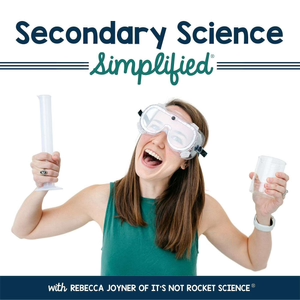
36. Teaching Anatomy: 5 Tips for the Best Year EVER!
Secondary Science Simplified™
08/22/22 • 15 min
Are you teaching Anatomy for the first time or have you taught it before but don’t feel super confident teaching it? This episode is for you! Today, I am sharing 5 tips for teaching anatomy to help both you and your students LOVE anatomy!
In many high schools, Anatomy is an elective class which allows you to have some flexibility and options in what you teach and how you teach it. In this episode, I am sharing 5 tips to help you teach an anatomy class that you and your students love and that is meaningful. I am sharing why and how to stick to YOUR goals for the class, the importance of prioritizing real world applications, why students should be doing research in Anatomy class, the importance of emphasizing the interconnectedness of the systems, and how to take advantage of seasonal opportunities to keep students engaged.
I need YOUR help! I am putting together an episode on tips to keep every learner engaged in science classes. I would love to hear from YOU on how you engage a diverse group of learners in your classes. All you have to do is record a short 30 second clip and it may be featured on an upcoming episode! Check out the details here!
Resources:
- How to be on the SSS podcast
- My Anatomy Curriculum
- Anatomy Exam Pack
- Control and Coordination Unit
- FREE Halloween Science Resources
- Protection Unit
- Download your FREE Classroom Reset Challenge.
- Follow, rate, and review on Apple Podcasts.
Check out the show notes for all resources mentioned in this episode: https://itsnotrocketscienceclassroom.com/episode36
Show more best episodes

Show more best episodes
FAQ
How many episodes does Secondary Science Simplified™ have?
Secondary Science Simplified™ currently has 187 episodes available.
What topics does Secondary Science Simplified™ cover?
The podcast is about How To, Chemistry, Productivity, Podcasts, Education, Science and Biology.
What is the most popular episode on Secondary Science Simplified™?
The episode title '48. 5 Ways to Reclaim Your Class Time' is the most popular.
What is the average episode length on Secondary Science Simplified™?
The average episode length on Secondary Science Simplified™ is 29 minutes.
How often are episodes of Secondary Science Simplified™ released?
Episodes of Secondary Science Simplified™ are typically released every 7 days.
When was the first episode of Secondary Science Simplified™?
The first episode of Secondary Science Simplified™ was released on Nov 22, 2021.
Show more FAQ

Show more FAQ